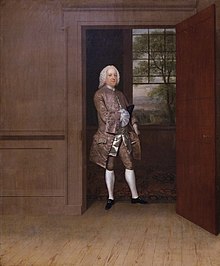Thomas Penn
This article includes a list of general references, but it remains largely unverified because it lacks sufficient corresponding inline citations. (April 2019) |
Thomas Penn | |
|---|---|
 Thomas Penn (Arthur Devis, 1752) | |
| 3rd Chief proprietor of Pennsylvania | |
| In office 1746–1775 | |
| Preceded by | William Penn |
| Succeeded by | John Penn |
| Personal details | |
| Born | March 20, 1702 Bristol, England |
| Died | March 21, 1775 (aged 73) England |
| Profession | proprietor of Pennsylvania |
Thomas Penn (March 20, 1702 – March 21, 1775) was a hereditary proprietor of the Province of Pennsylvania, the English North American colony that became the U.S. state of Pennsylvania. He was a son of William Penn, the colony's founder and original proprietor.
Biography[]
Early life[]
Thomas Penn was born in Bristol, England after his father returned there in 1701 because of financial difficulties. Thomas Penn's mother was his father's second wife, Hannah Callowhill Penn (1671–1726), daughter of Thomas Callowhill.
Proprietor of Pennsylvania[]
Penn inherited the position of Proprietor of the Colony of Pennsylvania for the British Crown in 1718 along with his brothers John and Richard on the death of their father William Penn, until 1746 when John died. Thomas continued as the Proprietor with Richard's son, John, and his own son John Penn until 1775. He tried to bring his family out of the debt that had plagued his father. He asserted his independence from the Quakers, and tried to assert his control of the colony almost as a feudal lord.
On May 12, 1732 Thomas with his brothers John and Richard, as the proprietors of Pennsylvania, signed an order to create a commission. This order was directed to Governor Gordon, Isaac Norris, Samuel Preston, James Logan, and Andrew Hamilton, Esquires, and to the gentlemen James Steel and Robert Charles. The commission, which was to be made up of at least three or more of these individuals, was given full power on behalf of the proprietors for the “running, marking, and laying out” of any boundary between Pennsylvania and Maryland. This was in accordance to the agreement signed between the Penn brothers and Charles Calvert, 5th Baron Baltimore on May 10, 1732.[1]
Arrival in Pennsylvania[]
Penn arrived in Pennsylvania in August, 1732, and organised the purchase of some of the lands at the outskirts of the Pennsylvania colony. He met with some of the local Indian chiefs and tried to keep the peace as immigrants poured into the countryside north and west of Philadelphia on the Susquehanna, Schuylkill, and Delaware Rivers. Many of the Indians did not want to sell their land, and had not heard of William Penn's 1686 treaty. Finally in 1737 Acting Governor James Logan convinced several Indian Chiefs to confirm the 1686 deed, which gave the Penns the land west of the Delaware River to the extent that a man could walk in a day and a half. Logan hired several men to walk the measure, but they walked west at a very fast pace and the Indians felt cheated. Logan and the Penn sons including Thomas were later criticized by some for this "Walking Purchase" and their questionable treatment of the Indians. Part of the difficulty lay in the conflict with the French who laid claim on the back country west of Pennsylvania, and the ensuing hostilities of King George's War (1744–1748) and the French and Indian War (1754–1763). Penn lobbied against Quaker efforts to make peace with the Iroquois and Algonquian tribes some of whom were allied with the French. The proprietor Penn brothers sold much of their western lands to European settlers, who did not know of the controversy and as a result, may have become resentful of the proprietors.
Penn tried to stop the introduction of Roman Catholicism in the colony. In 1733 a Catholic chapel was built in Philadelphia, and in 1734 Penn attempted to suppress the movement, but the Quaker-led legislative assembly protected the rights of Catholics to worship and build churches.
Penn visited the countryside of Pennsylvania to look for sites to establish towns and county seats. He appointed surveyors for the colony and for the "Lower Counties" which became Delaware, including Joshua Fisher, a prominent merchant in Lewes at the mouth of Delaware Bay. On one occasion in 1739, Penn visited the future site of Reading, Pennsylvania, where he found only one cabin. As Proprietor he realized the site would be good for the layout of a county seat because it sat in the Schuylkill River valley with hills nearby. Although he never returned to the site, the knowledge he gained on this visit was helpful later when he drew up the plan for Reading. He planned the street map and the water system, and helped surveyors and land agents with suggestions about the sale of lots, from which he stood to profit. Penn took the name from Reading, Berkshire, England and established the town in 1748, and on creation of Berks County in 1752, Reading became county seat.
Return to England[]

Penn returned to England and in 1751 joined the Church of England and married Lady Juliana Fermor, the daughter of Thomas Fermor, 1st Earl of Pomfret and Henrietta Louisa Jeffreys.[2] He did not hold many of the beliefs of the Quakers who had come to Pennsylvania, and lived the life of an aristocrat who had taken from the poor, identifiably different from his Quaker father who had tried to purchase land fairly from the Indians and live a life of peace.
The politics of the colony were complex, with the Quaker population declining and the legislature increasingly at odds with its proprietor. In 1756, Penn attempted to remove the Quakers from power in the colony by having a petition granted by Parliament that would require an oath of loyalty in all colonial legislative assemblies. Because the Quakers never took oaths, they would be banned from power. The attempt failed and the colonial Quakers remained free of any oaths to Parliament.
Penn sent his nephew John Penn to govern the colony in 1763. The new governor faced many problems: Pontiac's Rebellion, disputes over the Penn family lands and taxation, as the proprietary interest paid little or no tax on their vast land holdings in the colony.[3]
Dispute with Benjamin Franklin[]
Efforts were made by Pennsylvanians to persuade Penn to pay taxes; these were led by Benjamin Franklin, who in 1757 travelled to England to pursue the colonists' grievances. [3] The two men soon came to dislike one another; Penn regarded Franklin as a troublemaker, saying "I should be very Glad he inhabited any other Country, as I believe him of a very uneasy Spirit."[3] Franklin in turn described Penn as "a low Jockey", and said that he "conceived that moment a more cordial and thorough Contempt for him than I ever before felt for any Man living -- a Contempt that I cannot express in Words."[3] Failing in his diplomatic efforts, Franklin also tried unsuccessfully to persuade the Crown to have the Penn proprietary government replaced with a royal government.[3]
Death and legacy[]
Thomas Penn died in Stoke Poges, Buckinghamshire England on March 21, 1775, soon before the American Revolution brought an end to the Penn family's control of Pennsylvania. He is buried in St Giles' churchyard, Stoke Poges near to the grave of the poet Thomas Gray who had preceded him by four years.[4]
See also[]
References[]
- ^ Proud, Robert (1798). The History of Pennsylvania in North America From the Original Institution and Settlement of that Province, Under the First Proprietor and Governor William Penn, in 1681, till after the year 1742: With an Introduction Respecting the Life of W. Penn, Prior to the Grant of the Province, and the Religious Society of the People Called Quakers, with the First Rise of the Neighbouring Colonies, More Particularly of West-New-Jersey and the Settlement of the Dutch and Swedes on Delaware. To Which is Added a Brief Description of the said Province, and the General State in which it Flourished, Principally between the years 1760-1770. With an Appendix. Written principally between the years 1776 and 1780. Philadelphia, PA: Zachariah Paulson, Jr. pp. 206–219.
- ^ Person Page 3610. Thepeerage.com (2008-12-02). Retrieved on 2013-07-15.
- ^ Jump up to: a b c d e New York Times, 22 Sept 1996 Retrieved 12 August 2021
- ^ Nicholas B. Wainwright.The Penn Collection. The Pennsylvania Magazine and Biography, 87(4) 1963 pp. 393-419 [1]
- Lorett Treese. The Storm Gathering: The Penn Family and the American Revolution. 1992; rept. Stackpole Books, 2002.
- Penn Family Papers, 1629-1832. Historical Society of Pennsylvania.
- William A. Hunter. "The Walking Purchase." Harrisburg: Pennsylvania Historical and Museum Commission:Harrisburg, 1972. 2nd Ed. [2]
- Steven Craig Harper. Promised Land: Penn's Holy Experiment, The Walking Purchase, and the Dispossession of Delawares, 1600-1763. Lehigh University Press, 2006.
- Francis Jennings. "Thomas Penn's Loyalty Oath." In The American Journal of Legal History Vol. 8, No. 4 (Oct., 1964), pp. 303–313.
- Francis Jennings. Empire of Fortune: Crowns, Colonies, and Tribes in the Seven Years War in America. Norton, 1988.
External links[]
- People of colonial Pennsylvania
- Converts to Anglicanism from Quakerism
- 1702 births
- 1775 deaths
- Penn family
- English people of Welsh descent